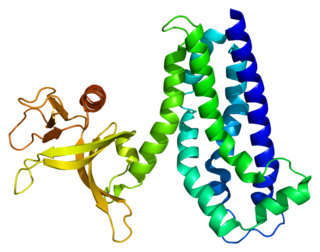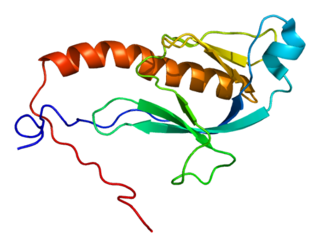
Guanine nucleotide exchange factors (GEFs) are proteins or protein domains that activate monomeric GTPases by stimulating the release of guanosine diphosphate (GDP) to allow binding of guanosine triphosphate (GTP). A variety of unrelated structural domains have been shown to exhibit guanine nucleotide exchange activity. Some GEFs can activate multiple GTPases while others are specific to a single GTPase.

RhoGEF domain describes two distinct structural domains with guanine nucleotide exchange factor (GEF) activity to regulate small GTPases in the Rho family. Rho small GTPases are inactive when bound to GDP but active when bound to GTP; RhoGEF domains in proteins are able to promote GDP release and GTP binding to activate specific Rho family members, including RhoA, Rac1 and Cdc42.

Rho guanine nucleotide exchange factor 7 is a protein that in humans is encoded by the ARHGEF7 gene.

A-kinase anchor protein 13 is a protein that in humans is encoded by the AKAP13 gene. This protein is also called AKAP-Lbc because it encodes the lymphocyte blast crisis (Lbc) oncogene, and ARHGEF13/RhoGEF13 because it contains a guanine nucleotide exchange factor (GEF) domain for the RhoA small GTP-binding protein.

Dock180, also known as DOCK1, is a large protein involved in intracellular signalling networks. It is the mammalian ortholog of the C. elegans protein CED-5 and belongs to the DOCK family of Guanine nucleotide exchange factors (GEFs).

Plexin B1 is a protein of the plexin family that in humans is encoded by the PLXNB1 gene.

RhoG is a small monomeric GTP-binding protein, and is an important component of many intracellular signalling pathways. It is a member of the Rac subfamily of the Rho family of small G proteins and is encoded by the gene RHOG.

Triple functional domain protein is a protein that in humans is encoded by the TRIO gene.

Dock2, also known as DOCK2, is a large protein involved in intracellular signalling networks. It is a member of the DOCK-A subfamily of the DOCK family of guanine nucleotide exchange factors (GEFs) which function as activators of small G proteins. Dock2 specifically activates isoforms of the small G protein Rac.

Dedicator of cytokinesis protein 10 (Dock10), also known as Zizimin3, is a large protein involved in intracellular signalling networks that in humans is encoded by the DOCK10 gene. It is a member of the DOCK-D subfamily of the DOCK family of guanine nucleotide exchange factors, which function as activators of small G proteins.

Dock4, also known as DOCK4, is a large protein involved in intracellular signalling networks. It is a member of the DOCK-B subfamily of the DOCK family of guanine nucleotide exchange factors (GEFs) which function as activators of small G proteins. Dock4 activates the small G proteins Rac and Rap1.

DOCK8, also known as Zir3, is a large protein involved in intracellular signalling networks. It is a member of the DOCK-C subfamily of the DOCK family of guanine nucleotide exchange factors (GEFs) which function as activators of small G proteins.

Dock3, also known as MOCA and PBP, is a large protein involved in intracellular signalling networks. It is a member of the DOCK-B subfamily of the DOCK family of guanine nucleotide exchange factors (GEFs) which function as activators of small G proteins. Dock3 specifically activates the small G protein Rac.

Dock9, also known as Zizimin1, is a large protein involved in intracellular signalling networks. It is a member of the DOCK-D subfamily of the DOCK family of guanine nucleotide exchange factors that function as activators of small G proteins. Dock9 activates the small G protein Cdc42.
DOCK is a family of related proteins involved in intracellular signalling networks. DOCK family members contain a RhoGEF domain to function as guanine nucleotide exchange factors to promote GDP release and GTP binding to specific Small GTPases of the Rho family, leading to their activation since Rho proteins are inactive when bound to GDP but active when bound to GTP.
DHR1, also known as CZH1 or Docker1, is a protein domain of approximately 200–250 amino acids that is present in the DOCK family of signalling proteins. This domain binds phospholipids and so may assist in recruitment to cellular membranes. There is evidence that this domain may also mediate protein–protein interactions.
DHR2, also known as CZH2 or Docker2, is a protein domain of approximately 450-550 amino acids that is present in the DOCK family of proteins. This domain functions as a guanine nucleotide exchange factor (GEF) domain for small G proteins of the Rho family. DHR2 domains bear no significant similarity to the well described DH domain present in other RhoGEFs such as Vav, P-Rex and TRIO. Indeed, the most divergent mammalian DHR2 domains share only 16-17% sequence similarity.

Dock5, also known as DOCK5, is a large protein involved in intracellular signalling networks. It is a member of the DOCK-A subfamily of the DOCK family of guanine nucleotide exchange factors (GEFs) which function as activators of small G proteins. Dock5 is predicted to activate the small G protein Rac.

Dock6, also known as Zir1 is a large protein involved in intracellular signalling networks. It is a member of the DOCK-C subfamily of the DOCK family of guanine nucleotide exchange factors which function as activators of small G proteins.

Dock11, also known as Zizimin2, is a large protein involved in intracellular signalling networks. It is a member of the DOCK-D subfamily of the DOCK family of guanine nucleotide exchange factors (GEFs) which function as activators of small G proteins. Dock11 activates the small G protein Cdc42.




















